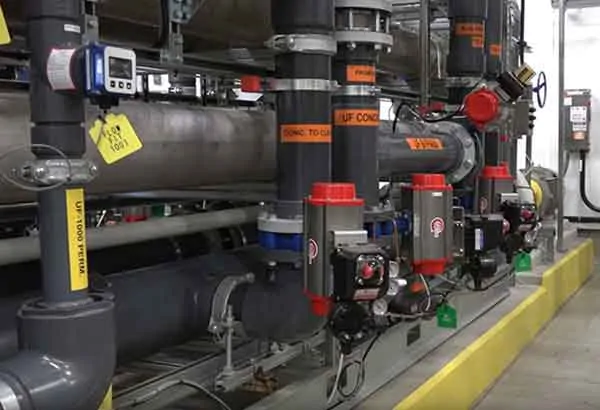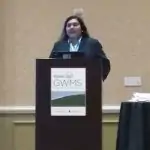


Across the industry, stakeholders agree the next few years will be critical in shaping how landfills deal with PFAS and how the public perceives it. Waste trade associations, scientists, and a host of organizations are in the midst of conducting a number of studies looking closely at the issue, PFAS treatment options, the positive impact of recycling, and regulatory policies.
While there are sites noted in the article, there’s no practical way for most companies and landfills to respond at this time responsibly. Additionally, landfills are unique; no two are alike. Most human exposure to PFAS occurs through contaminated food. The majority of landfill leachate is pre-treated at the landfill before going to a wastewater treatment plant, where additional treatment occurs before discharge.
According to EREF President Dr. Bryan Staley, in the article, “The relative impact of leachate as a human exposure pathway needs further evaluation to understand its relative degree of importance as it relates to health implications.”

Dr. Gomathy Radhakrishna Iyer, landfill leachate and design expert for SCS Engineers, said some operators are waiting to see what regulations may come even as they work on accounting for potential compliance issues and seeking solutions. “When the clients are thinking of upgrading their treatment plans, some are definitely taking into consideration PFAS treatment,” Radhakrishna Iyer said.
“You’re spending millions of dollars, you need to do your due diligence, right? At this point, consideration should be given to PFAS treatment during the feasibility stages,” she said.

Complementing the Interstate Technology and Regulatory Council’s – ITRC, PFAS Technical and Regulatory Guidance, the website now has ITRC Per- and Polyfluoroalkyl Substances – PFAS, and Risk Communication Fact Sheets available. The site and updated content replace older fact sheets with more detailed information and useful for those who wish to understand the discovery and manufacturing of PFAS, information about emerging health and environmental concerns, and PFAS releases to the environment with naming conventions and federal and state regulatory programs.
SCS Engineers’ professionals recommend further reading to understand specific chemicals or subgroups of chemicals under study to comprehend PFAA behavior in the environment. There are appropriate tools to develop a site-specific sampling and analysis program and considerations for site characterizations following a PFAS release.
We combine ITRC resources and our own to compile an updated library that we hope you find helpful. You can always contact one of our local Liquids Management or Landfill professionals too.
PFAS Behavior in the Environment
PFAS Concerns
PFAS Evaluations
PFAS Remediation
The Interstate Technology and Regulatory Council (ITRC) is a state-led coalition working to reduce barriers to the use of innovative air, water, waste, and remediation environmental technologies and processes. ITRC documents and training can support quality regulatory decision making while protecting human health and the environment. ITRC has public and private sector members from all 50 states and the District of Columbia and is a program of the Environmental Research Institute of the States (ERIS), a 501(c)(3) organization incorporated in the District of Columbia and managed by the Environmental Council of the States (ECOS).
ITRC Goals
SCS Engineers
Industrial stormwater discharge regulatory compliance defined by the National Pollutant Discharge Elimination System – NPDES, and the Federal Multi-Sector General Permit – MSGP, slated for implementation in January 2021, will affect state Industrial General Permits. In the states where the EPA is the regulating body (New Mexico, New Hampshire, and West Virginia), the impact will be immediate.
California on the Rise, by Jonathan Meronek and Alissa Barrow, discusses the emerging general commonalties of “lessons learned” that can help dischargers successfully manage their stormwater programs.
Jonathan and Alissa explain best practices that help businesses understand and prepare ahead of the expected changes. The strategies can streamline preparation and response to minimize risk and help prevent fines and lawsuits.
About the Authors: Jonathan Meronek is a State of California IGP Qualified Industrial Stormwater Practitioner – QISP. With SCS Engineers for over 17 years, he leads Stormwater Management in the Southwest U.S. Alissa Barrow has 10 years of experience as an environmental professional specializing in environmental assessment, remediation, and compliance. Find a stormwater professional near you.
Learn more:
The unsung hero at landfills with a landfill gas collection system is the humble Wellfield Technician. The position of Wellfield Technician is multifaceted; this individual needs to be well equipped to deal with constant changes. A good technician is capable of:
All while communicating effectively with those on their team, during all kinds of weather and changing conditions.
One practice that most good Technicians embrace is keeping effective field notes. Those not engaging in this practice should consider doing so. Field notes and comments added to a row of monitoring data can be of great future value to the technician and the rest of the team. Accurate and detailed field notes contain information that can help the project team when it comes time to diagnose, repair, or troubleshoot various wellfield issues.
Whether it’s a handwritten entry in a logbook, a comment stored in a field instrument, or notes saved in a smartphone, tablet, or computer, the information recorded in field notes is indispensable for the proper, efficient maintenance of the wellfield.
Technicians are hard-pressed to recall every detail during the hectic daily push to get the wellfield read, while multitasking and keeping up with items that pop up at a moment’s notice. By keeping track of this information through note-taking or SCSeTools®, the technician can be more efficient over time – they won’t be scratching their head, trying to remember a detail important to a task.
Examples of items we track in our database include: wellhead valve positions, surging in vacuum supply risers at wellheads, required maintenance of sample ports, flex hoses, audible wellhead leaks, ponding water around wells, surface cracks around a well, and borehole backfill material settlement.
Regardless of how recorded, save field notes as valuable points of reference.
Handwritten notes are entered into a preventative maintenance program or a wellfield database so that they are accessible for use in planning repairs or troubleshooting problems. Another option is to capture them automatically, even noting the GSI coordinates into a database such as SCSeTools, to save time and lessen transcription errors.
Once completing wellfield monitoring and tuning, technicians then use comments or notes as a punch-list to return to the wellfield − ready to perform maintenance or repairs. These are the actions that keep the landfill gas collection components operating efficiently, and clients’ happy.

Learn more about Landfill Services here.
SCS Engineers’ Gomathy Radhakrishna Iyer explains, “The structure of PFAs is a carbon and fluorine bond, and that bond is considered one of the strongest in nature. For industry, Chlorofluorocarbons (CFC), a volatile derivative of methane, ethane, and propane, creates problems globally after they’ve been released. Chlorofluorocarbons are strong greenhouse gases and are also responsible for the destruction of stratospheric ozone.
The most publicized of these compounds are those used as coolants in refrigeration and air conditioners, as propellants in spray cans and similar products, and as solvents for industrial purposes. Chlorofluorocarbons are far less abundant than carbon dioxide in the atmosphere. Still, they are 10,000 times more potent as a greenhouse gas and can remain in the atmosphere for more than 45 to 100 years. Reference
Iyer continues, “PFAS has the same kind of carbon-fluorine bond as CFC but linked to several C-F bonds like a chain making them even more inert and hard to degrade. Breaking this bond is what makes finding effective leachate treatments challenging, but certainly possible.”
It takes a savvy engineer to design safe and effective systems. We’re very proud of our Young Professionals like Gomathy – they’re smart and continue learning with the guidance of our VEPs – very experienced professionals.
Open positions at SCS Engineers for YPs and VEPs
President, Michele Nestor
Vice President, Denise Wessels
Secretary, Tom Lock
Treasurer, Matthew Foltz
Private Sector Directors: Jill Hamill, Carolyn Witwer
Public Sector Directors: Scott McGrath and Scot Sample
Young Professionals Director: Brandon Comer
Chapter International Board Member: Robert Watts
The Solid Waste Association of North America – SWANA organization is comprised of public and private sector professionals committed to advancing solid waste management, safety, and resource management through their shared emphasis on education, advocacy, and research. Keystone SWANA serves industry professionals through technical conferences, certifications, publications, and a large offering of technical training courses which in turn keep our communities and environmental resources healthier.
The Los Angeles County Board of Supervisors designated Alpine Village in Torrance, a Historic Landmark. The parking lot is a former landfill, and in the early ’70s, SCS Engineers designed building protection/sub-floor ventilation systems for several on-site structures. Once completed, SCS entered into contracts to monitor, maintain, prepare, and submit regulatory reports that the firm still performs well to this day.
“As we celebrate our 50th Anniversary, Alpine Village is an example of one of SCS’s oldest and longest continuously running projects,” said President and CEO Jim Walsh. We’re proud that we provide valuable environmental services to businesses and communities.”
Dave Ross, Senior VP (retired), said, “This certainly underscores SCS’s longevity and sustained superior client service. I can recall the elation when we won the first LFG [landfill gas] monitoring job there…I completed one of the earliest rounds of [air] sampling on the roof of the main building.”
Learn more about SCS Engineers and the award-winning environmental services this employee-owned firm provides.
SWANA is offering educational sessions as a webinar series with CEUs available from August through November. Register for just a few or pay one flat fee to participate in as many as you would like.
This week’s Webinar is on Thursday, October 1 at 10:00 am ET, 1 CEU.
State-of-the industry practices pertaining to the design, construction, operations, monitoring, and data analytics of LFG collection and control systems, as well as investigation of the quantity (mass flux) of fugitive (uncollected) LFG emissions.
Webinar Schedule and Registration
This 1 hour SWANA Training includes topics on Landfill Gas Emissions. Register through the VRA/SWANA Webinar Series. If you’d like to learn more about the services and technologies discussed during this session, try one of these links:
SCS periodically prepares Technical Bulletins to highlight items of interest to our clients and friends who have signed up to receive them. We also publish these on our website at https://www.scsengineers.com/publications/technical-bulletins/.
Our most recent Bulletin summarizes the
This Bulletin provides information on these revisions, as follows:
“An ounce of prevention is worth a pound of cure.” We’ve all heard that proverb before, and it’s true – it’s generally easier to stop something from happening than to repair the damage after it has happened.
This is almost always the case when it comes to environmental incidents – it is cheaper to prevent the incident from occurring than paying for the cleanup and impacts the incident caused. Many of SCS’s service areas are specifically focused on prevention and optimization – doing the job in ways that are better, safer, and more protective of human health and the environment.
Environmental insurance is a product that most SCS clients likely have in place in some form to protect their facilities, employees, and neighbors from the harmful impacts of incidents that can introduce contamination into the air, soil, groundwater, or surface water. The types of coverage provided by environmental insurance policies vary in both extent and cost, and many factors, one of which being risk, drive those costs. When an insurance company is underwriting coverage for a new or existing client, the risk associated with that coverage is carefully evaluated. What the client (insured) does, how they do it, their safety record, their history of previous environmental issues, and other factors are all taken into consideration when writing an environmental insurance policy and the associated premium and deductible are determined.
To reduce the up-front costs (the premium) associated with carrying the necessary and appropriate amount of environmental insurance, the insured can do several things. One is to increase their deductible, but in the event of an incident, that could end up costing the insured more on the back end (i.e., costs expended to investigate and remediate an incident). Insureds, their brokers, and the insurers will work closely to balance premium costs and deductibles so that the costs associated with addressing an incident are not detrimental.
An insured shouldn’t reduce the type and amount of coverage – that could put them in a bad financial (and legal!) position. A more prudent choice, one that has many potential positive aspects and makes sound business sense, is reducing risk and therefore the costs associated with an environmental insurance policy that is based on coverage and risk.
SCS Engineers develops proprietary remote monitoring and control software for landfills, manufacturing, and industrial facilities called SCS RMC®. The software provides remote real-time viewing, analysis, and control of equipment and systems critical to safe operations and production. A network of sensors and Machine-to-Machine (M2M) applications enable operations teams to be alerted immediately (via cell phones, computers, tablets) of any operational issues that could potentially result in an environmental incident.

The application reduces reaction time, labor costs, and potential associated impacts. In this case, SCS RMC® puts the client’s decision-making in front of a problem rather than reacting to potential aftermaths, proactively reducing the potential environmental risks of their operations.
SCS’s service areas, including those listed here, are particularly focused on providing our clients with assistance in designing, building, and maintaining sustainable solutions, reducing risk, and helping to foresee and adapt to environmental, social, and regulatory changes:
SCS’s professionals are available to assist our clients in their discussions with brokers and insurers regarding how our environmental services and technologies can potentially reduce risks associated with their operations. We do this by providing creative and cost-effective solutions and guidance that can prevent environmental incidents from occurring and reducing the nature and extent of associated impacts.
We can help you select and implement the “ounce of prevention” so that you won’t have to face the “pound of cure.” This will proactively reduce operational risks, which can, in turn, help facilitate the positive brokering of more favorable environmental insurance coverage, premiums, and deductibles.
